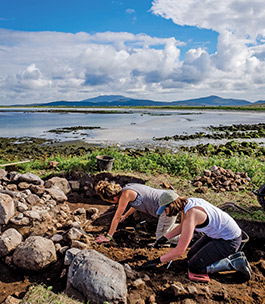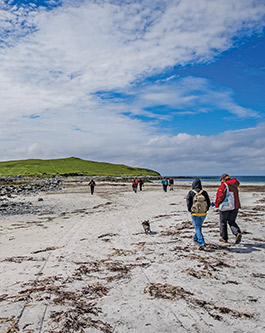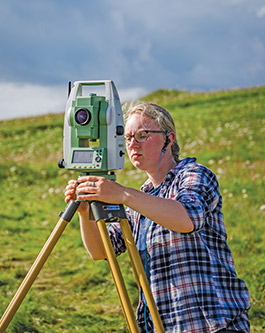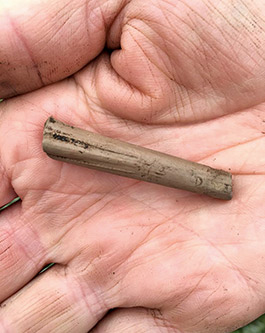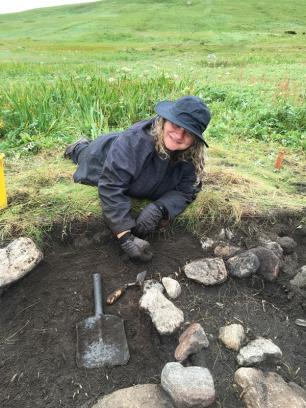Mapping Human History in the Hebrides
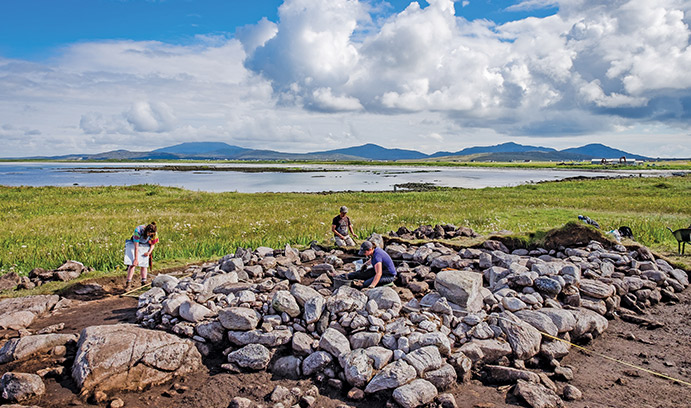
Off Scotland’s coast, archaeologists race against time and climate.
Thirty miles or so off the northwest coast of Scotland, a windswept, mostly treeless chain of islands called the Outer Hebrides harbors some of Europe’s richest archaeological treasures.
Human beings have inhabited the Outer Hebrides for perhaps 10,000 years, since the end of the Ice Age. Prehistoric hunters and gatherers of the Stone Age gave way to farmers who practiced animal husbandry and horticulture. The Bronze and Iron Ages, the Middle Ages and the modern era brought civilizations that fought and intermingled: Picts, Gaels, Romans, Vikings, Scots and Britons.
Fallen houses and burial mounds, shards of pottery, arrows and farm tools, and other artifacts and structures are the only clues to how these bygone peoples lived, worked, worshiped and buried their dead. Some remnants, like the Callanish Standing Stones erected around a tomb 4,000 years ago, are impossible to miss. But most are buried beneath the peat that covers much of the Hebrides.
For the scientists seeking to piece together a fuller picture of human history on the Hebrides, says Cameron Wesson, time is running out. Many of the archipelago’s archaeological sites, he says, lie well below sea level on the coastal machairs—the low-lying grassy plains and sand dunes that buffer the islands from the sea.
Over the past several decades, says Wesson, sea waters have risen, overwhelming some of the machairs and encroaching onto the islands. An increase in the frequency and intensity of storms has also eroded the shoreline. As a result, some archaeological sites that once overlooked the water now lie underwater 20 to 30 feet offshore.
In an effort to discover and document artifacts before they are claimed by the Sea of the Hebrides, Wesson, the Lucy G. Moses Distinguished Professor in the Department of Sociology and Anthropology, and archaeologist Niall Sharples of Cardiff University in Wales led a group of students on a four-week expedition last summer.
Twelve students from Lehigh and six from Cardiff took part in the excavation, conducted on Orasay, a tiny, uninhabited island connected by a sandbar to the much larger island of South Uist.
Working eight hours a day in sun and rain, the students spent much of their time sitting or kneeling in trenches, sifting through soil with spades, shovels, trowels and mattocks—hand tools similar to pickaxes that are used for digging and chopping.
With a pencil and a piece of paper, the students sketched drawings of the rocks and other features in each square meter of their trenches. They also used a 15-pound, battery-operated drone with an ultra-high definition camera to take aerial photos of the sites and a laser-equipped Total Station Surveyor to record the exact position, in 3D, of each artifact they found. The surveyor calculated the density of found items for each square foot of the trenches, and compared the results.
“Thanks to the Total Station,” said Karl Schmidt ’17, “next year’s group can save time because it will already know the location of previous finds and the places where they should start looking first.”
Schmidt, an IDEAS (Integrated Degree in Engineering, Arts and Sciences) major, has taken three anthropology courses with Wesson; this was his first dig.
“To be in the field and to dig up something that people haven’t seen for hundreds or thousands of years—even it’s just a piece of pottery, it’s pretty thrilling to be a part of that,” he said Schmidt.
Hanna Schulman ’19, a double major in finance and accounting, was thrilled to uncover the stem of a smoking pipe engraved with the name David and the number 7. Because of the size of the hole inside the stem, she said, the pipe is estimated to be 300 to 500 years old.
“It may not have been the greatest find,” said Schulman, “but it was a real thing I could imagine someone using.”
The trip to Orasay was also an eye-opener for Ally Fraser ’17, a materials science and engineering major.
“I was really surprised how much I enjoyed archaeology,” she said. “I didn’t know what to expect. I hadn’t taken any anthropology classes before. The professors told us how to hold a trowel, how to dig, how to look for things and tell what’s important. Then they threw us into the trenches and told us, ‘You’re on your own. This trench is your oyster.’
“We learned about history by digging up history.”
The other students on the Lehigh team study electrical engineering, mechanical engineering, psychology, and earth and environmental sciences. Two are anthropology majors. Some assigned reading and a yen for international learning were the only prerequisites for the adventure, which counted for six academic credits.
This was a very eclectic group,” said Wesson. “Each student brought a different perspective. I want future businesspeople, lawyers and doctors to understand why it’s important to learn about the past and to be good informed citizens.”
The idea for the Orasay expedition took shape in 2013, when Wesson received a grant from the international affairs office to explore research connections overseas. Wesson contacted Sharples, who is an expert in the archaeology of the Hebrides and the Shetland Islands. The two met in Wales to discuss the possibility of a summer archaeological camp and settled finally on the Outer Hebrides.
The Mellon Digital Humanities Initiative in the College of Arts and Sciences provided funding for the drone and the iPad that operated it, and for a 3D camera to record and digitize artifacts. The Lehigh students are making a documentary film and plan to give a presentation about the project this fall at the Steel Stacks.
On Orasay, the Lehigh-Cardiff team excavated four separate sites between the machairs and a low-lying boggy area. In four weeks of digging, they uncovered evidence of more than 5,000 years of human habitation, spanning the Neolithic age to the 19th century and including fragments of arrowheads, tools and pottery.
“Our best find,” said Wesson, “was a late Iron Age house whose shape, size and construction are found in only one other house on all the Hebrides. During that time period, most houses were rectilinear or square in shape. Our house is circular with side chambers off the main area.
“There are other circular houses, but ours has the unique shape of a kidney bean with an entrance and side chamber that are different. We’re not sure if the side chamber was for cooking or something else.”
The group also continued digging at Dun Vulan, a broch circled by 30-foot-high stone edifices that Sharples partially excavated more than 20 years ago. A broch is a massive, hollow-walled, Iron Age stone structure found only in Scotland.
“Dun Vulan is an amazing structure,” Wesson wrote in his expedition blog, “but it is poised right along the sea coast and has been damaged by coastal erosion. We [want] to try and recover as much information as possible about the broch before it disappears completely.”
The archaeologists also began excavating several Neolithic Age cairns, or circular mounds of stones that hold monuments to the dead. The larger sizes of some of the cairns, said Wesson, could reflect the importance of the person buried within or the size of the community—with more people, more hands could be enlisted to pile rocks.
“We found Neolithic pottery near two of the cairns,” Wesson said. “Some pottery pieces were topped with ceramics from the 1700s and with bottles and other debris littered there in recent years.”
In another find, the group uncovered field rows and standing stone walls just beneath the surface of the earth. These dated from the 18th century, said Wesson, and showed how people marked the land to indicate who owned which plots. Some of these people were “kelpers” who gathered kelp from the sea and dried and burned it for fuel.
The United Kingdom’s antiquities laws require archaeological artifacts to remain in the UK, said Wesson, so the artifacts that the group found will stay in Scotland to be studied by Scottish archaeologists.
“We did not bring any artifacts to Lehigh, but we’re going to print 3D images of them with a 3D printer to do further studies,” he said.
If he can secure funding, Wesson hopes to take a second group of Lehigh students back to the Outer Hebrides next summer. More excavating remains to be done at Dun Vulan, and further study is needed to determine if the side chamber of the kidney bean-shaped Iron Age house was used for cooking or something else.
“The summer camp in Scotland will continue as long as there is student interest, as long as my knees hold out, and as long as the Scots let us.”
* * *
The daily routine…
…was regimented. At 8 each morning, a bus picked the Lehigh students up from their dormitories at the University of the Highlands and Islands on South Uist. By 8:30, the team had taken their positions on the island of Orasay.
Work in the trenches was broken up by a half-hour lunch at 1 p.m. and 15-minute tea breaks at 11 a.m. and 3:30 p.m. A designated “tea master” left the site 30 minutes before each break to boil water and set up tables with milk, sugar and cookies.
“Tea was sacred, especially for the British students,” said Fraser. “They would sprint across the sandbar to get to tea.”
At 5 p.m., the students stowed their tools and boarded the bus for home.
The weather determined the working conditions. Temperatures seldom exceeded 60 and dipped occasionally into the 30s. The North Atlantic wind was steady at 20 to 40 mph. Rain often forced the students to wear water gear, but, said Wesson, “the rain always soaked us no matter what we were wearing.”
The tide kept its own schedule. When it rose, it covered the sandbar connecting Orasay to South Uist; obligating the students to leave the island.
Sometimes, said Schulman, the sheer wonder of the scenery interfered.
“On the island of Orasay,” she said, “the view was equally spectacular everywhere you looked. The entire island was green. Out on the ocean, the water was the purest, darkest blue. Closer in, it was turquoise and along the shore it was clear. The colors didn’t blend at all; it was as if there was a line separating them.
“Sometimes we’d just stop and watch and say to each other, ‘This makes the rain worthwhile.’”
Photographs by Rachel Biddy
Posted on:


